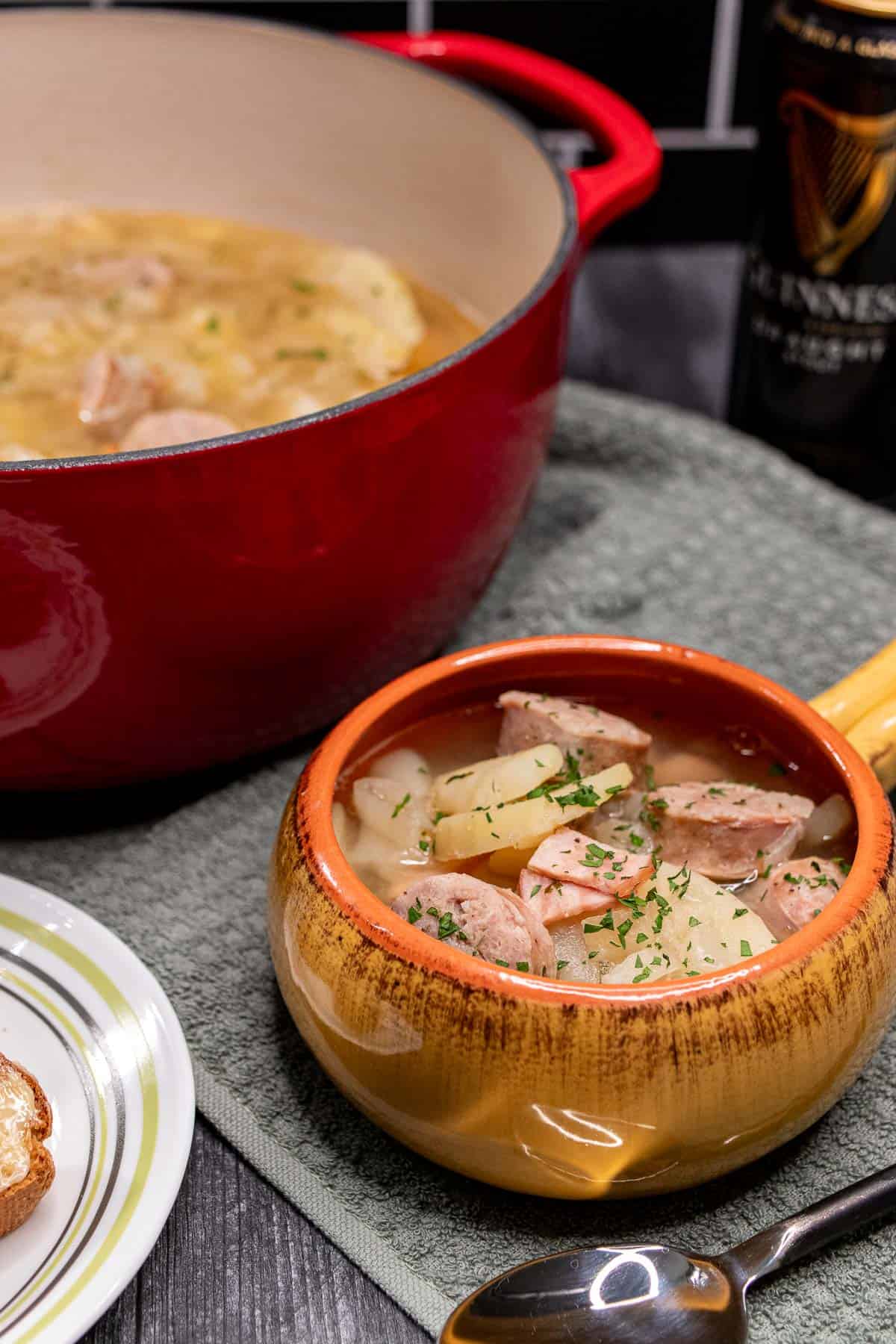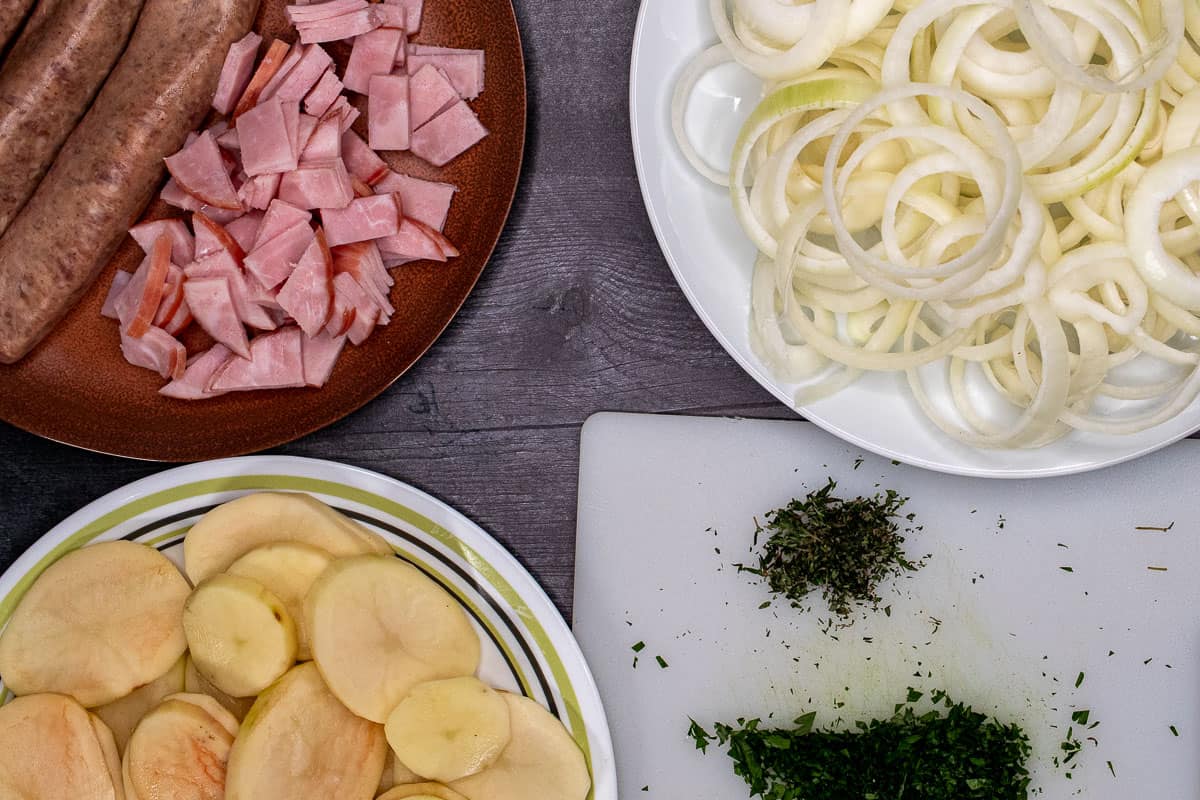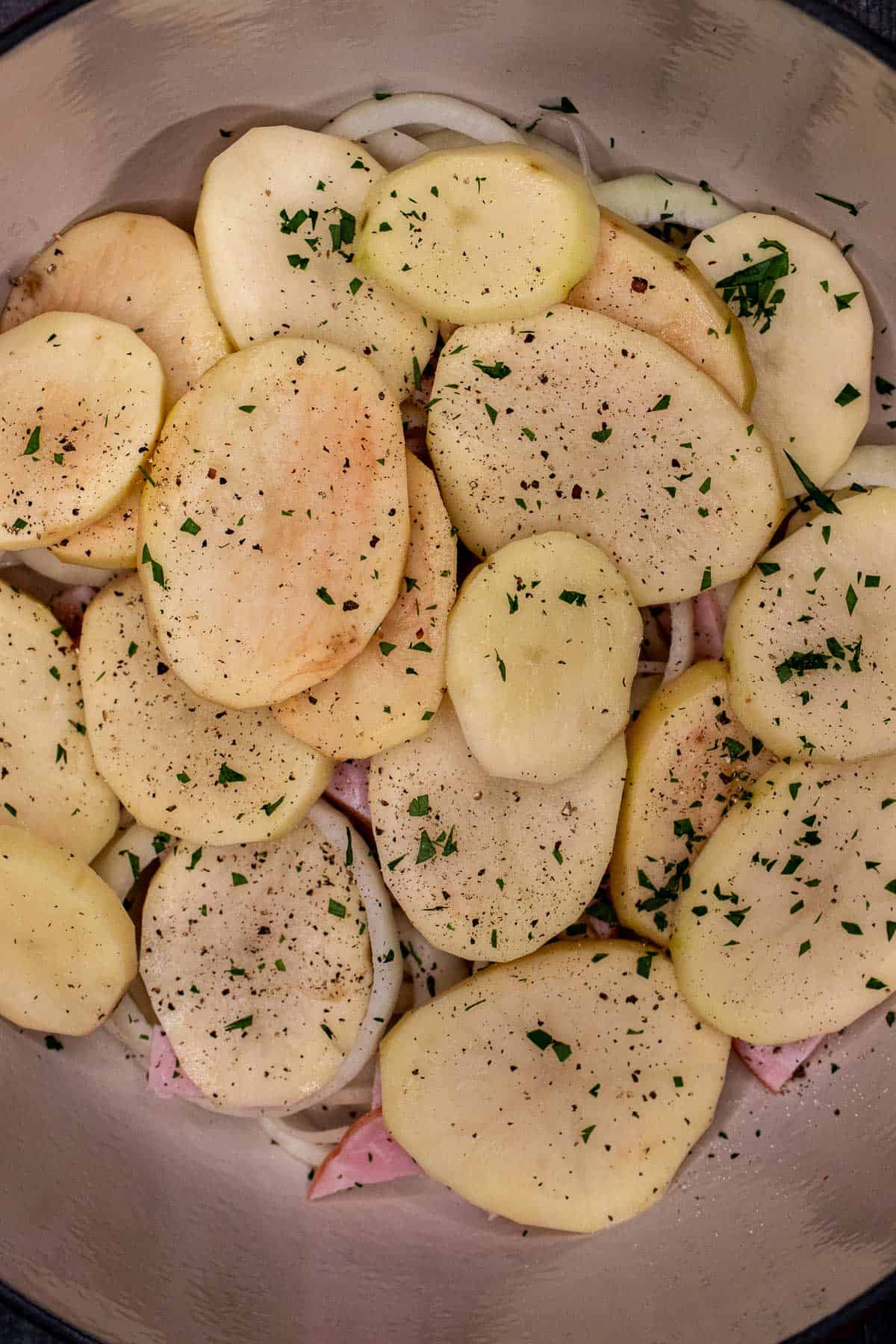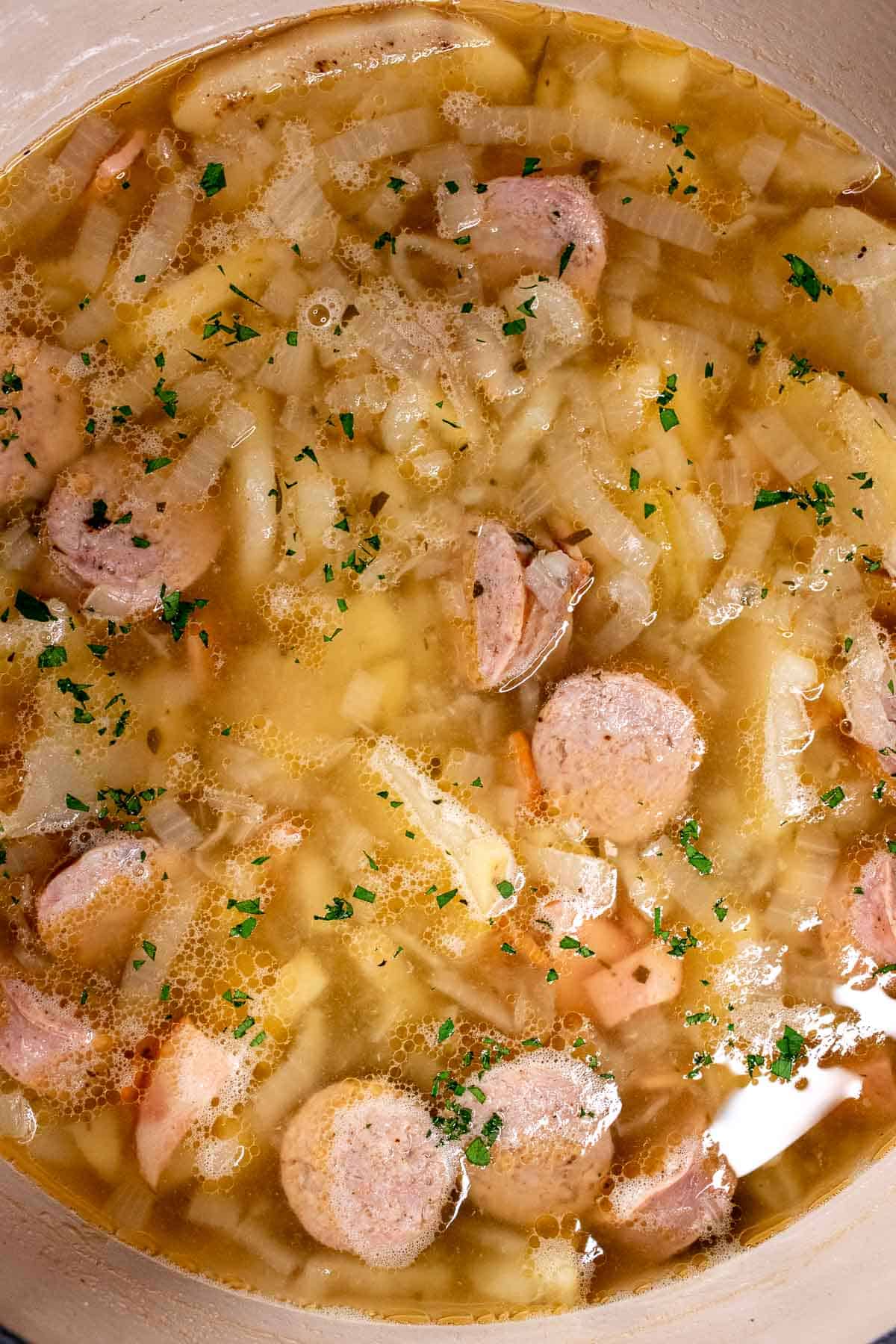Irish coddle, or Dublin Coddle, is an Irish stew made from simple ingredients and cooked in a simple manner. It’s a hearty stew and perfect for a cold day. Dublin coddle is an authentic Irish dish with a rich history and is a working-class meal in all the best ways.
Dublin coddle is a hearty, traditional Irish meal like Guinness Irish stew, that started in the home and is a modern staple in Irish pubs. While it can show up in different parts of the country, coddle is almost specifically found in the capital of Dublin, hence the typical association in the name as opposed to just “Irish Coddle.”
At its core, a Dublin coddle recipe is a simple and rustic dish composed of just potatoes, onions, Irish sausage, and bacon, cooked in water or stock. This is also a dish that’s almost specifically meant to eat reheated instead of fresh. It was a meal that was made earlier in the day and left to cool, then heated up for dinner later after an evening at the pub or the movies. I actually love it this way as well, since the potatoes break down some and the starchy water naturally thickens the dish.
Be sure to bake up some Irish soda bread or Guinness brown bread to go along with this stew. Smeared with some good Irish butter, it’s the best way to soak up the liquid and really make this a filling meal. Some pubs also serve this with mashed potatoes.

This dish isn’t without controversy either. Because it is simply simmered, the stew can be a bit off-putting to the uninitiated. Since nothing is browned before cooking, the stew can have a bland appearance as the bacon and sausages almost look uncooked. Some Dubliners take this as a point of pride and feel browning the meat is a cop-out. Don’t be fooled by the look though, as this stew is hearty and full of wonderful flavor.
Jump to:
🥘 Ingredients for Dublin Coddle
As mentioned above, this dish is very simple and combines sausage, bacon, potatoes, and onions simmered in water or stock. There’s a few other ingredients people use, some considered modern additions and others considered traditional, but these could also be ingredients that are just how different families made their version.

Potatoes – A lot of Irish dishes call for “floury” potatoes, including this one. Some recipes prefer waxy potatoes because of the long simmer time here. A good choice here for US cooks would be Russet potatoes.
Waxy potatoes like Yukon Gold potatoes can be used instead since they don’t need to be peeled and won’t break down as easily. I prefer Russets because I like the potatoes breaking down some as it helps thicken the coddle. Go with your preference.
Onions – I use large, yellow onions here, but sweet or white onions would be fine as well.
Sausage – If you can find Irish bangers, that’s ideal for this recipe. Check local butchers or grocery stores that make their own sausage. If you can’t find any, look for uncooked quality pork sausages like pork bratwurst.
Bacon – Irish rashers are what would traditionally go here, and if you can find them, go with that. This is what is typically served in Ireland and the UK when someone says “bacon” and is back bacon that is much leaner than American bacon, which they refer to as “streaky bacon.”
The closest substitute would be Canadian bacon in the US, but you can also just use some thick cut bacon if you want (because of the way this is cooked, I recommend Canadian bacon first though).
Stock – Originally simmered in water and salt, using stock or broth is much more common these days. Use chicken or vegetable stock/broth, but if you can find or make it, ham stock is also common and delicious.
Seasoning – Just some simple salt and pepper is all you need here. I hate to say “to taste” but the amount of salt you use here will really depend on what liquid you cook with. Between water, unsalted broth, low sodium broth, or regular broth/stock, you’ll want to adjust how much salt you add.
Herbs – Both of these are optional but add some nice flavor and well needed color. Sometimes considered traditional depending on who you ask, flat-leaf parsley makes a good addition. A little more modern, and the only non-traditional ingredient I add, is fresh thyme.
🔪 How to Make Dublin Coddle
This is an easy one pot dish that comes together in about an hour or so. Whether you call it a soup, a stew, or even a casserole because of how it’s layered, it’s a simple dish that’s more than the sum of its parts.
The onions are usually cut into rings, and the potatoes can be cut into slices or chunks. Cut the bacon into medium sized pieces but leave the sausage whole. Since it’s typically made from uncooked pork sausage in a casing, leave them whole while cooking and you can cut it into chunks when serving.

Start by cutting the onions into rings and peel and slice the potatoes. If you have a mandolin, this is a great time to use it and slice both about a ¼” to ½” thick. It’s not necessary, but useful in keeping everything uniform so that it cooks evenly. If using Irish rashers or Canadian bacon, slice into roughly ½” x 1” pieces and set aside.


Set a 5–6-quart Dutch oven on the stove on medium heat. Add half the onions and bacon on the bottom and top with ½ the thyme and of the parsley. Layer half the potatoes on top of that and season with salt and black pepper. Layer again with the rest of the onions and bacon, the rest of the thyme and another ⅓ of the parsley, reserving the rest to add when serving. Add the rest of the potatoes, again with some salt and pepper, and place the sausages on top of everything.


Now pour in the chicken stock (or whatever you choose to use) and turn the heat to high. If you prefer the dish a little soupier, add an extra 2 cups of water or stock. The liquid level will seem kind of low, but the onions and potatoes will break down and sink as it cooks and be much wetter than it seems at first. The sausages should be resting at the top, just above the liquid so that they can steam. When it comes to a boil, cover and reduce to a simmer.


Cook, covered, for 45 minutes to an hour. You can also cook for 30 minutes covered and uncover it and cook on low another 30 minutes to reduce some of the liquid if it is too soupy for your liking. Remove the sausages and slice into chunks and return to the pot. Ladel into bowls and serve immediately with a bit of the leftover parsley to garnish.
Alternatively, and suggested, allow the stew to cool completely and then refrigerate. Reheat portions on the stove when ready to serve.
🥣 What is a Coddle?
Coddling is a style of cooking that basically means to heat food in water below the boiling point. In the past it referred to fruit but is mostly associated with cooking eggs. Coddled eggs are like poached eggs, but instead of cooking the egg directly in the water, the egg is placed in a ramekin or something similar and placed in a hot water bath to cook more slowly.
I’m not sure exactly how or why this dish got its name, but the cooking method is more like stewing or braising. Some recipes will toss everything together in a pot with enough liquid to just cover everything and let it stew. Other recipes will leave the sausage whole and rest just above the liquid so that it steams while everything cooks.

📜 Irish Coddle Origin
The earliest reports of Irish coddle dishes date back to the Irish famine in the 1700s. Stews like this would help stretch out the use of cheap ingredients like sausages and root vegetables, especially while grains were scarce.
Because Ireland was also a very Catholic country, most people did not eat meat on Fridays. The coddle was a good way to use up leftover meats and root vegetables on Thursdays for a cheap and nutritious meal.
The reason for the ties to Dublin specifically probably comes from a few sources. As people moved from the country areas into Dublin to find work, they usually brought livestock such as pigs with them to raise for food. When slaughtered and sold, they would keep some of the remains to make sausages with. When added with onions and potatoes in a coddle, it made inexpensive meals that could be stretched out.
Later, it was supposedly a favorite dish of Irish dramatist and playwright Seán O’Casey, who wrote about the Dublin working class. The dish is also mentioned in some of the works of the Irish novelist James Joyce.

📖 Recipe Variations
Other than the addition of fresh thyme, this is an authentic recipe for a traditional Dublin coddle. Some of the variations here include ingredients that some consider modern changes and others as traditional, all depending on who you ask. The famous Gallagher’s Boxty House in Dublin has a traditional Dublin coddle on their menu and it’s made with black pudding sausages and ham hock, so feel free to experiment.
Vegetables – Some modern recipes include carrots, which can add a bit of sweetness to the dish. Sometimes greens are added as well, such as leeks, cabbage, or kale. Adding some of these options can bring more color and flavor to a simple dish.
Grains – Some recipes consider this traditional, but the addition of barley can make this coddle thicker and a bit more filling as well.
Browning – Considered a cop-out by traditionalists, browning the ingredients before cooking undeniably adds a new layer of flavor to this recipe. Since the sausages and rashers don’t render out much fat, you may want to add a bit of oil or Irish butter to the pot before browning them.
Brown the sausages first, then the bacon, removing both after browning. Add the onions and cook until they get some color, then add everything in like normal and cook as directed.
Guinness – A bit more of a modern addition, Dublin coddle with Guinness brings another level of flavor to the dish. Some recipes will add a splash of Guinness near the end of the cooking process, but if you’re browning everything as well, try deglazing the pot with a cup of Guinness when the onions are done and reduce the amount of stock.

💭 Frequently Asked Questions
At its simplest, Dublin coddle is made from onions, potatoes, sausage, and bacon, cooked in water or stock. Other variations include things like carrots, leeks, cabbage, barley, parsley, and Guinness.
Imagine a soup with onion and potato with a bit of a salty and porky flavor to it. The sausage and bacon make for a hearty Dublin coddle, while the potatoes help thicken the broth from their starch.
Coddle is traditionally a simple one pot dish with a handful of ingredients and made with pork. Irish stew tends to be a deeper and richer dish made with beef or lamb and includes more vegetables and herbs and cooks for a longer time to break down the meat.
🍽 Recommended Equipment
Being a simple dish to prepare and cook, there’s nothing really fancy needed to make this. Here’s two items I wanted to mention though.
Mandolin – As mentioned above, you can definitely cut the onions and potatoes with a knife, but a mandolin helps make quick work of this. I don’t break this out too often, but a mandolin is useful for keeping the ingredients uniform so that they cook up evenly.
Dutch Oven – I always recommend a good quality 5–6-quart Dutch oven for every home cook. They’re just so versatile and can be used on the stove or in the oven. They’re perfect for braising or frying and everything in between.

❄️ Storing & Freezing Coddle
This is definitely a recipe meant to eat reheated, so leftovers taste even better. Let the coddle cool completely and you can store it in an airtight container in the refrigerator for 3-4 days. You can reheat in the microwave, but for the best results, reheat in a small pot on the stovetop.
I don’t typically recommend freezing dishes with chunks of potatoes since they don’t hold up as well to freezing and thawing. However, if you do have a lot of leftovers or make a big batch, you can freeze Dublin coddle in an airtight container for 3-4 months. Thaw overnight in the fridge before reheating.
📋 Recipe
Dublin Coddle
Ingredients
- 1 pound pork sausage, see note 1
- ½ pound bacon, see note 2
- 2 pounds Russet potatoes, peeled and sliced
- 2 large yellow onions, sliced into ½” rings
- 4 cups chicken stock, see note 3
- 1 teaspoon fresh thyme leaves, optional
- 2 tablespoons finely chopped flat leaf parsley
- Salt and black pepper to taste, see note 3
Directions
- Start by cutting the 2 yellow onions into rings and peel and slice 2 pounds of Russet potatoes. If you have a mandolin, this is a great time to use it and slice both about a ¼” to ½” thick. It’s not necessary, but useful in keeping everything uniform so that it cooks evenly. If using Irish rashers or Canadian bacon, slice into roughly ½” x 1” pieces and set aside.
- Set a 5–6-quart Dutch oven on the stove on medium heat. Add half the onions and bacon on the bottom and top with ½ the thyme and ⅓ of the parsley. Layer half the potatoes on top of that and season with salt and black pepper. Layer again with the rest of the onions and bacon, the rest of the thyme and another ⅓ of the parsley, reserving the rest to add when serving. Add the rest of the potatoes, again with some salt and pepper, and place 1 pound pork sausages, uncut, on top of everything.
- Now pour in 4 cups chicken stock (or whatever you choose to use) and turn the heat to high. If you prefer the dish a little soupier, add an extra 2 cups of water or stock. The liquid level will seem kind of low, but the onions and potatoes will break down and sink as it cooks and be much wetter than it seems at first. The sausages should be resting at the top, just above the liquid so that they can steam. When it comes to a boil, cover and reduce to a simmer.
- Cook, covered, for 45 minutes to an hour. You can also cook for 30 minutes covered and uncover it and cook on low another 30 minutes to reduce some of the liquid if it is too soupy for your liking. Remove the sausages and slice into chunks and return to the pot. Ladel into bowls and serve immediately with a bit of the leftover parsley to garnish.
- Alternatively, and suggested, allow the stew to cool completely and then refrigerate. Reheat portions on the stove when ready to serve.






Comments
No Comments